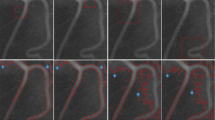Abstract
This work presents a novel approach termed minimum path based region growing (MP-RG) to extract 3-D coronary vessels. Using the joint convexity information of orientated 1D vessel profiles to build the potential function, a single-point minimum path searching is applied to guide the region growing to achieve effective vessel lumen extraction. The searching priority for sparsely distributed vascular structures allows an efficient implementation of the MP-RG algorithm. Only one start point is required to be set to extract a 3-D vessel tree. Especially, an effective stopping criteria is developed for the region growing process. We test the effectiveness of the proposed MP-RG by using clinical coronary CT data, and the encouraging performance of the proposed method is validated.
Access this chapter
Tax calculation will be finalised at checkout
Purchases are for personal use only
Preview
Unable to display preview. Download preview PDF.
Similar content being viewed by others
References
World Health Organization (WHO), The top ten causes of death - Fact sheet N310 (2008)
McInerney, T., Terzopoulos, D.: Deformable models in medical image analysis: A survey. Med. Image Anal. 1(2), 91–108 (1996)
Duncan, J., Ayache, N.: Medical image analysis: Progress over two decades and the challenges ahead. IEEE Trans. Pattern Anal. Mach. Intell. 22(1), 85–105 (2000)
Pham, D., Xu, C., Prince, J.: Current methods in medical image segmentation. Annu. Rev. Biomed. Eng., Annu. Rev. 2, 315–337 (2000)
Kirbas, C., Quek, F.: A review of vessel extraction techniques and algorithms. ACM Comput. Surveys (CSUR) 36(2), 81–121 (2004)
Lesage, D., Angelini, E.D., Bloch, I., Funka-Lea, G.: A review of 3D vessel lumen segmentation techniques: Models, features and extraction schemes. Med. Image Anal. 13(6), 819–845 (2009)
Wan, S., Higgins, W.: Symmetric region growing. IEEE Trans. Image Process. 12(9), 1007–1015 (2003)
Boskamp, T., Rinck, D., Link, F., Kmmerlen, B., Stamm, G., Mildenberger, P.: New vessel analysis tool for morphometric quantification and visualization of vessels in CT and MIR imaging data sets. Radiographics 24(1), 287–297 (2004)
Yi, J., Jong Beom, R.: A locally adaptive region growing algorithm for vascular segmentation. International Journal of Imaging Systems and Technology 13(4), 208–214 (2003)
Metz, C., Schaap, M., Van Der Giessen, A., Van Walsum, T., Niessen, W.: Semi-automatic coronary artery centerline extraction in computed tomography angiography data. In: Proc. IEEE Int. Symp. Biomed. Imaging, pp. 856–859 (2007)
Miguel, A., Palomera-Pérez, M., Elena, M.P., Hector, B.P., et al.: Parallel Multiscale Feature Extraction and Region Growing Application in Retinal Blood Vessel Detection. IEEE Trans. Information Technology in Biomedicine 14(2), 500–506 (2010)
Bock, S., Kühnel, C., Boskamp, T., Peitgen, H.: Robust vessel segmentation. In: Med. Imaging 2008: Computer-Aided Diagnosis. SPIE, vol. 6915 (2008)
Wink, O., Niessen, W., Viergever, M.: Multiscale vessel tracking. IEEE Trans. Med. Imag. 23(1), 130–133 (2004)
Li, H., Yezzi, A.: Vessels as 4-D Curves: Global Minimal 4-D Paths to Extract 3-D Tubular Surfaces and Centerlines. IEEE Transactions on Medical Imaging 26, 1213–1223 (2007)
Benmansour, F., Cohen, L.D.: Fast Object Segmentation by Growing Minimal Paths from a Single Point on 2D or 3D Images. J. Math. Imaging and Vision 33(2), 209–221 (2009)
Friman, O., Hindennach, M., Kühnel, C., Peitgen, H.O.: Multiple hypothesis template tracking of small 3D vessel structures. Med. Image Anal. 14(2), 160–171 (2009)
Author information
Authors and Affiliations
Editor information
Editors and Affiliations
Rights and permissions
Copyright information
© 2013 Springer-Verlag Berlin Heidelberg
About this paper
Cite this paper
Chen, Y., Cao, Q., Zhuang, Z., Yang, Z., Luo, L., Toumoulin, C. (2013). 3-D Coronary Vessel Extraction Using a Novel Minimum Path Based Region Growing. In: Kamel, M., Campilho, A. (eds) Image Analysis and Recognition. ICIAR 2013. Lecture Notes in Computer Science, vol 7950. Springer, Berlin, Heidelberg. https://doi.org/10.1007/978-3-642-39094-4_57
Download citation
DOI: https://doi.org/10.1007/978-3-642-39094-4_57
Publisher Name: Springer, Berlin, Heidelberg
Print ISBN: 978-3-642-39093-7
Online ISBN: 978-3-642-39094-4
eBook Packages: Computer ScienceComputer Science (R0)




